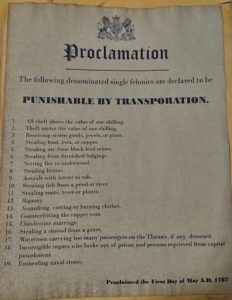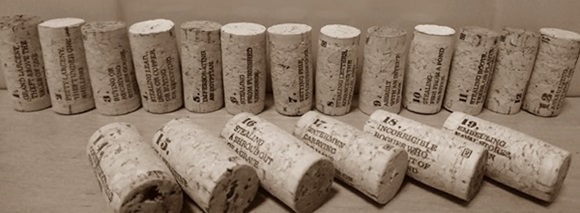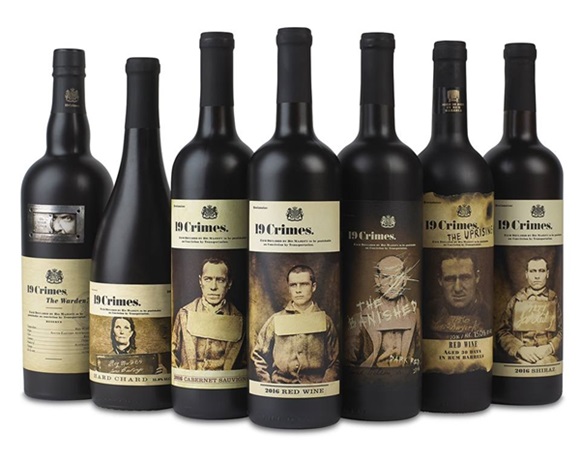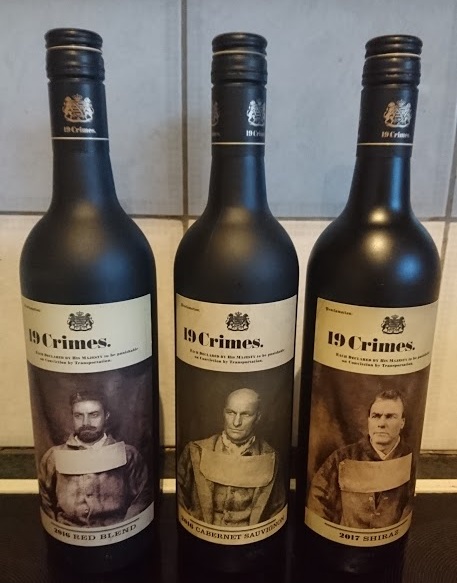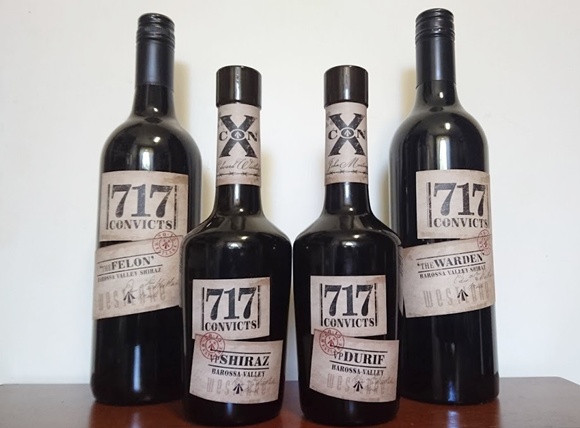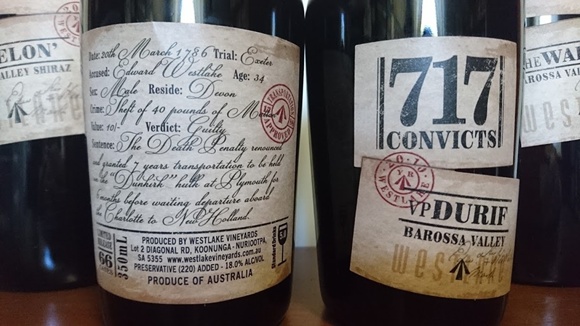History and Wine Part 2: 19 Crimes
Following on from my earlier post about convict wine, now we’re on to Part 2. And we have more history, more wine, and more convicts with “19 Crimes“.
This wine is what got me started me on the whole “convict wine” thing. And you know what … it was actually a Canadian friend who introduced me to it. Thankyou Ellen. I’ll admit I’m not a wine fanatic, but I am a history and family history buff … so anything with a convict on it is going to get my attention. So I’ve researching this wine to suss out the stories behind it all.
So it’s made in my home state of South Australia as a brand for Treasury Wine Estates, and 19 Crimes is sold locally in Australia, and overseas as well. And it was first made in 2012, so how did I not know about this until now?
So what’s so cool about 19 Crimes wine?
The Corks = The Crimes
Did you know that there were 19 reasons for transportation? No, nor did I. And each of these reasons is written on a cork. So if you’re a collector like me you wan to get the whole set. But it can be a challenge as they are added randomly you never know what you’ll get. So if you buy 2 bottles of the same wine you may get different corks, or you may get the same … you’ll never know until you open it. As a collector I’ve found it fun collecting the whole set, although I did have to bend the rules a little, since the Australian version of the wine doesn’t come with corks, but rather screwtops … so I headed to ebay, and little-by-little got the whole 19.
As a historian, it’s interesting to see this list which was proclaimed on 1st May, 1787.
The following is the list of crimes that was punishable by transportation to Australia
1. All theft above the value of one shilling
2. Theft under the value one shilling
3. Receiving stolen goods, jewels or plate
4. Stealing lead, iron or copper
5. Stealing ore from black lead mines**
6. Stealing from furnished lodgings
7. Setting fire to underwood
8. Stealing letters
9. Assault with intent to rob
10. Stealing fish from a pond or river
11. Stealing roots, trees or plants
12. Bigamy
13. Assaulting, cutting or burning clothes
14. Counterfeiting the copper coin
15. Clandestine marriage
16. Stealing a shroud from a grave
17. Watermen carrying too many passengers on the Thames, if any drowned
18. Incorrigible rogues who broke out of prison and persons reprieved from capital punishment
19. Embeuling naval stores
**Note: the 19 Crimes version of Number 5 says Impersonating an Egyptian. I’m not sure where they got that from, but it’s an odd one.
The Labels = The Criminals
Secondly the labels. There’s currently 3 convict pictures on the Australian version of the 19 Crimes wine, with 7 different ones for the overseas market (6 with convict pictures on them). However I have just had notification from the manufacturers that they are currently in the process of changing the Australian bottles to match the US ones – and will be releasing them over the course of the next year.
Treasury Wine Estates writes ..
“The men featured on our wine labels are not those of fiction. They were flesh and blood. Criminals, artists and scholars. In history, they share a bond – receiving “punishment by transportation” for violation of one of 19 crimes and becoming the first settlers of a new nation.”
So the convicts that appear on the overseas bottles (and soon to be released updated Australian bottles) of 19 Crimes are:
John Boyle O’Reilly (Red Blend)
As a youth in Ireland, John Boyle O’Reilly was a member of the Irish Republican Brotherhood, or Fenians, for which he was transported to Western Australia. After escaping to the United States, he became a prominent spokesperson for the Irish community and culture, through his editorship of the Boston newspaper The Pilot, his prolific writing, and his lecture tours.
Michael Harrington (Cabernet Sauvignon)
Convicted for his part in the well documented escape (the Catalpa Rescue) of the Militant Fenian band of convicts from Fremantle Prison, Western Australia. There’s a great article about this on the Smithsonian magazine site.
Jane Castings (Hard Chard)
Married with 4 young children, and employed as a housemaid, in 1846 Jane was sentenced to 7 years transportation for “receiving cheese and bacon knowing the same to have been stolen”.
James Wilson (The Banished)
Born James McNally in Newry, County Down, Ireland in 1836, he joined the British Army at the age of 17 (enlisting under a false name), before returning to Ireland where he became a Fenian in 1864. On 10 February 1866, he was arrested by the police who discovered him hiding in a safe house in Dublin. Wilson, along with other military Fenians were tried, found guilty of desertion and mutinous conduct, and sentenced to death. However, this sentence was later commuted to penal servitude for life, and they were transported to Western Australia. In October 1867, Wilson and sixty one other Fenians began the long sea voyage on board the Hougoumont to Australia.
Cornelius Dwyer Kane (The Uprising)
Cornelius Dwyer Kane (aka Keane) (1839-1891) had been a law clerk and cener from Skibbereen, County Cork, Ireland. Transported abroad the Hougoumont he was conditially pardoned in 1871, but was forbidden from returning to Ireland, So he never reunited with his wife and children there. He did however, settle in Queensland and became a civil servant.
James Kiely (Shiraz)
James also played a part in the “Catalpa Rescue”, which obviously didn’t go to plan. He was convicted, sent to Western Australia “for life” imprisonment, however he was granted a pardon by the King in 1905. There’s a great article on Trove about this here.
I don’t have official confirmation from Treasury Wine Estates of the names of the three convicts on the current Australian bottles. But going by the pictures I would say that Henry Singleton (alias Richard Pinches) is one of them (the one on the right in the above photo). He was transported per the ‘Lady Kennaway’. You can read more about him here.
So next time you’re out at your local bottle shop and you see 19 Crimes wine on the shelf, it’s more than just a great look and brand name, there really is a story behind each convict on the label.
History and Wine Part 1: 717 Convicts
This is the first of two posts that I’m writing about wine, history and convicts! And I must say, that this topic is my newest fascination addiction.
So let me introduce you to the “717 Convicts”wine.
Made by Darren and Suz Westlake of Westlake Vineyards. They run a small, family operated business in the heart of the Barossa Valley, South Australia’s wine country. And their range “717 Convicts” is one of their brands, and is a tribute to the First Fleet, and tribute to Darren’s ancestors.
The story starts back in the county of Devon in England where Edward Westlake was tried for stealing 40 pounds of mutton to the value of 10/-., back in 1786. He was found guilty, and was sentenced to 7 years transportation, along with his father in law, John Mortimer and brother-in-law Noah Mortimer. All three got their “free ticket” to Australia aboard the “Charlotte”, which one of the 11 ships in the First Fleet., which left England in May 1787. You can read more about the ships (and the convicts ) here.
Edward, John and Noah were just three of the 100 males, 32 females and 30 crew aboard the “Charlotte” for a total of 252 days – that’s an incredible 8 months, 1 week, and 1 day. I’ve been on cruise ships and by day 12 I tend to get stir crazy – and that’s pure luxury compared to the conditions that these ships would have been, so there is no comparison. After all they were prisoners, and were treated like it too.
Anyway all three survived the voyage to New South Wales (not everyone did), and by March 1788 all three were then transferred on to Norfolk Island, as part of the founding group of prisoners sent there. You can read what the Westlake Vineyards writes about their convict history here.
Well-known Australian historian, Cathy Dunn who knows everything there is to know about Norfolk Island history, has a whole article on Edward Westlake, which you can read here.
Anyway back to the wine … there are four varieties available, although the first two were hard to find (but if you’re interested, keep an eye on ebay) …
– The Felon (Shiraz)
– The Warden (Shiraz)
– VP Durif
– VP Shiraz
The back labels on both The Felon and The Warden bottles have the following written …
“This wine is a tribute to the 717 convicts that survived the voyage to Port Jackson as part of the First Fleet in 1788. Edward Westlake was one of those convicts arriving aboard the “Charlotte”. Their stories of survival and hardship in this unforgiving land are an inspiration to us all … whether free of condemned man.”
While the VP Durif and VP Shiraz bottles have actual entries of Edward Westlake and John Mortimer with all the date of trial, place of trial, accused, age, sex, residence, crime, value, verdict, sentence and so on printed on the back label.
As a family historian, and one particularly fond of convicts (well, who isn’t eh) …. I find this totally awesome, and it’s such a nice way to not only remember their history, but honour their ancestors as well.
Spending 8 months on a boat, then arriving in a place that had basically nothing meant that both the officers and convicts faced starvation as supplies ran low, particularly when little could be grown on the land. While I don’t know the exact population of Sydney in 1788, I image it wasn’t much more than the 717 convicts who arrived, plus a number officers … but by 1800 Sydney had a population of around 3,000.
Edward Westlake survived the hardships that life threw at him. He married, had a family, and lived till to the good ol’ age of 76. And in 2017, 189 years after his death … he would have thousands of descendants. And despite the fact that he was a convict, he was a founding member of Australia’s history. Afterall, the convicts helped establish our country, making Australia what it is today.
And just one last comment, us genie folk totally love our convicts. To us having a convict in the family tree is “Australian royalty”. And if you’re lucky enough to be descended from a First Fleeter then that is “True Australian Royalty”.
So I’d like to say next time you visit your local liquor store why not pick up a bottle, but I doubt you’ll find it there. So if you’re interested why not buy one from Westlake Vineyards themselves, and support a small Australian business as well.
And for more info on the First Fleet, check out Wikipedia, as it has great page with a lot of stats.
Discovering Links: Convicts, Australian Royalty
Did you have an ancestor who was a petty thief, stealing just to survive, or one that was a full-on criminal? There’s no doubt that finding convict heritage for an Australian is what is known as “Australian Royalty”. It is GOLD.
For a start there’s a HEAP of fabulous records available to check out, and there’s plenty of places to search … here’s just some that I’ve used, and have collected together for you. Note these aren’t in any particular order, so you might need to read through them all to see if they are likely to be of use to you in your convict search.
Australia Day Blog Challenge: My Earliest Australian Ancestor
Australia Day is here, and I’ve just finished working on my post for the 2013 Australia Day Blog Challenge which is to write about my ‘earliest Australian ancestor’ as suggested by Helen V. Smith.
So I’ve spent two weeks pondering just WHO to write about. And you know when you get married the whole “what’s-yours-is-mine- thing”, well that means I’ve adopted all of my hubby’s reli’s too, so I’ve decided to write about Mr Lonetester’s earliest Australian ancestor, his 5x great grandpa (which makes Mr Lonestester a 7th generation Aussie). Anyway meet …

